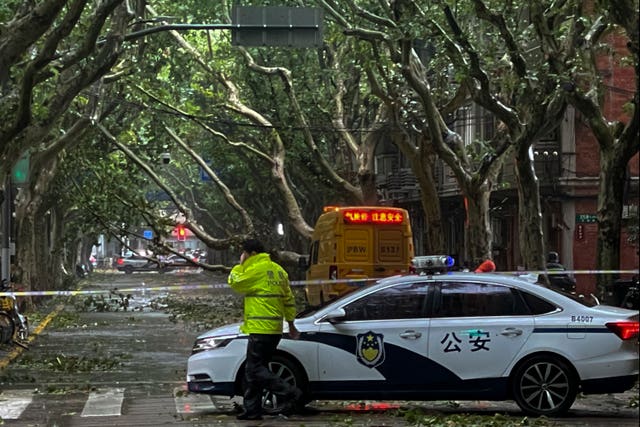Typhoon knocks out power to some homes in Shanghai
Flights, ferries and train services were suspended in Shanghai and neighbouring provinces, disrupting travel during China’s Mid-Autumn Festival.

The strongest typhoon to hit Shanghai since at least 1949 has flooded roads with water and broken tree branches, knocked out power to some homes and injured at least one person as it swept over the financial hub.
More than 414,000 people had been evacuated ahead of the powerful winds and torrential rain.
Schools were closed and people were advised to stay indoors.

He was taken to hospital for treatment.
Typhoon Bebinca made landfall at around 7.30am local time in the sprawling Pudong business district with winds of 151kph (94mph) near its centre.
Torrential rains flooded roads in the district, according to images broadcast by state media.
Elsewhere in Shanghai, uprooted trees and fallen branches blanketed some roads and pavements.
As the typhoon eased, responders cleared branches and other objects blown around by the storm.
More than 60,000 emergency responders and firefighters were at hand to lend aid in Shanghai.
Authorities said winds uprooted or damaged more than 10,000 trees and knocked out power for at least 380 households, damaging four houses.
At least 53 hectares (132 acres) of farmland were flooded.
The typhoon weakened as it moved inland, dousing parts of Jiangsu, Anhui and Zhejiang provinces.

Shanghai’s airports cancelled more than 1,400 flights, while in Hangzhou, about 170 kilometres (106 miles) southwest of Shanghai, authorities also cancelled more than 180 flights.
Flights at Shanghai’s airports resumed on Monday afternoon as the storm moved away.
Weather authorities expected Shanghai and parts of neighbouring provinces to receive up to 30 centimetres (12in) of rainfall between Monday and Wednesday.
Shanghai, which has 25 million people, is rarely hit by strong typhoons, which usually make landfall further south in China.
Typhoon Yagi hit China’s southern Hainan island earlier this month and has caused devastation in South East Asia.
In Myanmar, Yagi caused at least 74 deaths with dozens missing.
Four deaths were reported in Hainan, at least 10 people have died in Thailand and 20 in the Philippines.
Vietnam has reported more than 230 people killed in the typhoon and subsequent flooding and landslides, with dozens more still missing.





